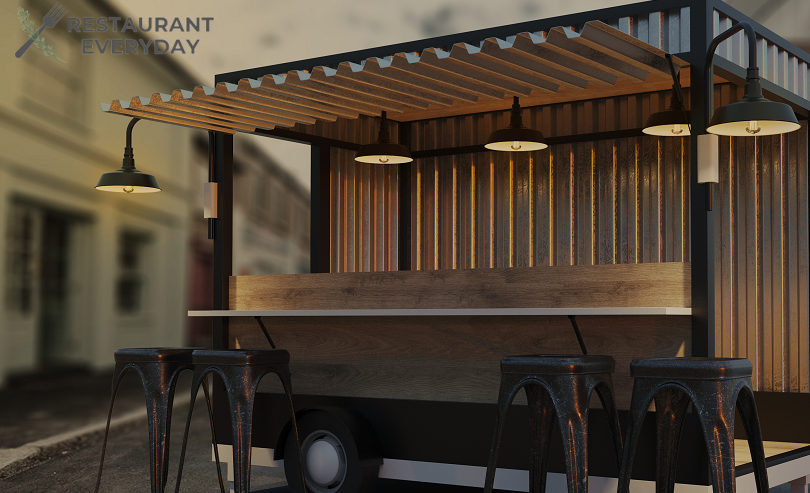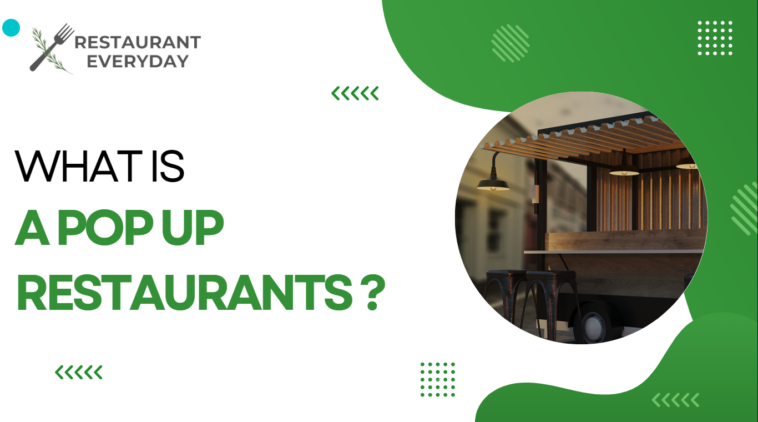Pop up restaurants have emerged as a dynamic and intriguing trend in the culinary world, offering a unique dining experience characterized by its temporary nature and innovative concepts. As culinary entrepreneurs seek novel ways to run restaurant and engage with their audience and experiment with creative gastronomic ideas, pop-up restaurants have gained remarkable popularity in recent years.
What is a Pop Up Restaurant Definition?
At their core, pop up restaurants are temporary dining establishments that materialize for a limited time, often in unconventional locations. These ephemeral spaces provide chefs and food enthusiasts with a platform to showcase their talents, experiment with diverse culinary concepts, and create memorable dining experiences. Unlike traditional restaurants, pop ups thrive on impermanence, making them a captivating and ever-changing feature in the culinary landscape.
The surge in the popularity of pop up restaurant can be attributed to a shift in consumer preferences, a desire for unique dining experiences, and the evolving nature of the food industry. Diners today crave more than just a meal; they seek immersive and distinctive encounters that transcend the ordinary. Pop up offer a solution to this demand, allowing chefs to captivate audiences with limited-time culinary innovations and creating a sense of exclusivity that appeals to modern food enthusiasts.
Purpose of a Pop Up Restaurant
Restaurants serve multiple purposes in the culinary world. For chefs, they provide a low-risk environment to test experimental menus, receive immediate feedback, and gauge market interest without the commitment of a permanent establishment. The transient nature of pop-ups also allows chefs to collaborate with other culinary professionals, fostering a culture of creativity and innovation within the industry.
The unique characteristics of pop up restaurant extend beyond their temporary status. These establishments often manifest in diverse and unexpected locations, such as abandoned warehouses, rooftops, or even outdoor spaces, adding an element of surprise and adventure to the dining experience. Limited seating, coupled with a focus on reservation-based access, contributes to an air of exclusivity, turning each pop-up event into a sought-after and memorable occasion.
The Origins of Pop Up Restaurant

The concept of pop up restaurants in United States has historical roots that trace back to various cultural and culinary phenomena. While the term “pop up restaurants” may be relatively modern, the idea of temporary dining experiences has historical antecedents. In the early 20th century, temporary food events like supper clubs and traveling food vendors provided a glimpse into the transient nature of culinary exploration. However, it wasn’t until the late 20th and early 21st centuries that the term “pop-up restaurant” gained prominence.
- Evolution in Culinary Trends
The evolution of these restaurants can be seen as a natural progression in the ever-changing landscape of culinary trends. As the food industry became more dynamic and consumers developed a heightened interest in diverse and experimental dining experiences, chefs and entrepreneurs sought new ways to engage their audience. The rise of celebrity chefs, food bloggers, and social media platforms played a pivotal role in shaping culinary trends, creating an environment where the temporary and the experimental were not only accepted but celebrated.
These restaurants became a canvas for chefs to break free from the constraints of traditional dining establishments. This evolution was fueled by a desire to move away from the predictability of standard restaurant offerings and embrace a more dynamic and interactive approach to food culture. The flexibility afforded by pop-ups allowed chefs to express their culinary creativity without the long-term commitment required by traditional brick-and-mortar establishments.
- Influences on the Pop-Up Phenomenon
Several factors have influenced the widespread adoption of pop-up restaurants. The rise of the “foodie” culture, characterized by an adventurous and discerning approach to dining, created a receptive audience eager to explore unique and limited-time culinary experiences. Additionally, the influence of globalization and the accessibility of diverse Indian cuisines through travel and the internet have broadened culinary horizons, fostering a culture of experimentation and openness to novel dining concepts.
Technological advancements, especially the ubiquity of social media, played a crucial role in popularizing pop up restaurant. Chefs and organizers leveraged platforms like Instagram, Twitter, and Facebook to generate buzz, share tantalizing previews, and create a sense of urgency around these temporary dining events. Social media became a powerful tool for spreading the word and building anticipation, contributing significantly to the rise and sustained popularity of pop up restaurant.
Pop Up Dining Experiences in USA
Pop up dining experiences have captivated both chefs and diners due to their unique and transient nature, offering a range of distinctive elements that contribute to their widespread appeal.
- Novelty and Exclusivity
Pop-up restaurants are celebrated for their ability to showcase novel and experimental culinary concepts. Chefs often use these temporary spaces to push the boundaries of traditional cuisine, presenting diners with innovative and unexpected dishes. The element of surprise and the chance to experience something new contribute to the allure of pop-up dining.
- Diverse Locations and Settings
Pop-up restaurants often choose unconventional locations, such as abandoned warehouses, rooftops, art galleries, or outdoor spaces. The choice of venue contributes to the overall experience, providing diners with a unique and immersive setting that goes beyond the typical restaurant environment. It also helps them deal with the food waste effectively in the surroundings
The diverse and changing locations of pop-up restaurants appeal to the sense of culinary adventure. Diners may find themselves exploring different neighborhoods or even cities to partake in these limited-time dining experiences. This aspect of culinary tourism adds an extra layer of excitement to the overall dining adventure.
- Limited-Time Offerings
Pop up restaurant are known for their limited-time menus and themed offerings. Chefs often create unique and carefully curated menus specifically for the duration of the pop-up. This encourages diners to seize the opportunity to try something they may not find elsewhere and adds a sense of urgency to the dining experience.
Some pop up restaurants align their offerings with seasons, holidays, or timely events. This approach allows chefs to tailor their menus to current trends, ensuring that the dining experience feels relevant and in tune with the moment. Diners are enticed by the prospect of enjoying dishes that are not only innovative but also timely.
How to Start a Pop Up Restaurant?
Starting a pop up restaurant in the United States involves a meticulous process that begins with the conceptualization of a unique and compelling idea. Define your pop-up’s concept, considering the type of cuisine, theme, and distinctive elements that will captivate diners. Extensive market research is essential to understand the demand for your concept, identify your target audience, and assess the competitive landscape.
With a well-defined concept, create a detailed business plan outlining key aspects such as your marketing strategy, budget, and financial projections. Securing funding is a critical step, whether through personal savings, loans, investors, or crowdfunding. Attend to legal considerations by registering your business, obtaining necessary licenses, and ensuring compliance with health and safety regulations.
Choose a location that aligns with your concept, negotiate terms with venue owners, and confirm that the space meets legal requirements. Collaborate with chefs, artists, or other creatives to enhance your pop-up’s appeal, and design a menu that reflects your concept and caters to your target audience.
Once the groundwork is laid, focus on operational logistics, including sourcing ingredients, hiring staff, and organizing the kitchen layout. Create a comprehensive marketing plan to generate buzz through social media, local press, and strategic partnerships. Prioritize an exceptional customer experience by paying attention to ambiance, service, and engagement.
Operational efficiency is crucial to the success of your pop-up, so ensure that you have the necessary equipment and resources to execute your menu seamlessly. After the pop-up event, evaluate performance by gathering feedback from customers and assessing overall outcomes. Use this information to refine your concept, address challenges, and plan for future pop-ups. The success of a pop-up restaurant hinges on innovation, adaptability, and a commitment to delivering a memorable dining experience.
Behind the Scenes: How Pop Up Restaurant Work
Pop Up restaurant involve meticulous planning, creative conceptualization, and strategic partnerships to bring temporary dining experiences to life. Understanding the behind-the-scenes process sheds light on the intricacies of orchestrating these unique culinary events.
- Planning and Conceptualization
- Concept Development: Chefs and organizers begin by conceptualizing a theme or unique culinary concept for the pop-up. This could involve experimenting with new dishes, cuisines, or innovative cooking techniques. The goal is to create a dining experience that stands out and resonates with the target audience.
- Menu Curation: The menu for the pop-up is carefully curated, often featuring limited-time offerings or special dishes that align with the chosen theme. Chefs may prioritize seasonal ingredients or incorporate timely culinary trends to enhance the appeal of the menu.
- Logistics and Operations Planning: Organizers meticulously plan the logistics and operations of the pop-up. This includes securing necessary permits, coordinating with suppliers for ingredients, and organizing kitchen equipment and staff. The temporary nature of pop-ups requires efficient planning to ensure smooth execution.
2. Venue Selection
- Unconventional Locations: Pop up restaurant thrive on the element of surprise, often choosing unconventional locations to create a unique ambiance. Selections may include abandoned warehouses, rooftops, art galleries, or outdoor spaces, adding to the overall allure of the dining experience.
- Collaboration with Venue Owners: Organizers collaborate with the owners of chosen venues to secure permissions, negotiate terms, and address logistical considerations. This collaboration is crucial for ensuring that the space aligns with the vision of the pop-up and can accommodate the unique requirements of a temporary restaurant.
- Adaptation to Different Spaces: Pop-up organizers must adapt to the specific characteristics of each venue. This could involve adjusting kitchen layouts, creating temporary dining spaces, and addressing any challenges posed by the chosen location.
3. Collaborations and Partnerships
- Chef Collaborations: Pop up restaurants often feature collaborations between chefs, bringing together culinary talents to enhance the dining experience. Joint efforts may involve creating a fusion of different cuisines, experimenting with diverse cooking styles, or combining culinary and mixology expertise.
- Partnerships with Brands and Sponsors: Collaborations with brands and sponsors can provide financial support and contribute to the overall experience. Brands may sponsor ingredients, kitchen equipment, or promotional materials, allowing organizers to enhance the quality of the pop-up and reach a broader audience.
- Marketing and Promotion: Strategic partnerships play a crucial role in marketing and promoting the pop-up. Social media influencers, food bloggers, and other collaborators can help generate buzz, create anticipation, and attract a larger audience to the temporary dining event.
Tips For Opening a Pop Up Restaurant
- Choose a high-traffic location or collaborate with existing businesses for visibility.
- Craft a unique and appealing concept or theme for your pop-up restaurant.
- Utilize social media, local influencers, and partnerships for effective marketing.
- Keep the menu focused and manageable, highlighting signature dishes or specialties.
- Partner with nearby establishments for cross-promotion and a broader customer base.
- Create a memorable atmosphere or unique dining experience to set your pop-up apart.
- Plan the duration carefully, considering short-term exclusivity or longer engagements.
- Incorporate mobile payment options for a streamlined customer experience.
- Connect with the local community through events, sponsorships, or collaborations.
- Encourage patrons to provide feedback to refine offerings and enhance satisfaction.
- Ensure compliance with health and safety regulations and obtain necessary permits.
- Utilize scarcity and exclusivity to create a sense of urgency through limited-time promotions.
- Stay adaptable and flexible to adjust offerings based on customer feedback and trends.
- Capture customer information to build an email list for direct communication.
- Conduct a thorough evaluation after the pop-up concludes, analyzing sales data and feedback.
- Use insights gained to refine your approach for future pop-up ventures.
Benefits Of Pop Up Restaurant
- Flexibility: Pop-up restaurants offer flexibility in terms of location, duration, and concept. Owners can test new ideas, experiment with different cuisines, and engage with diverse audiences without committing to a long-term lease.
- Low Overhead Costs: Compared to traditional brick-and-mortar restaurants, pop-up ventures typically have lower overhead costs. They often require minimal investment in infrastructure, equipment, and staffing, making them financially accessible for aspiring chefs and entrepreneurs.
- Creative Freedom: Pop-up restaurants provide chefs and culinary professionals with a platform to showcase their creativity and culinary skills. With fewer constraints compared to permanent establishments, chefs can design innovative menus, explore unique themes, and experiment with unconventional dining experiences.
- Marketing and Branding Opportunities: Pop-up restaurants generate buzz and excitement within the community, attracting food enthusiasts, bloggers, and media attention. They serve as effective marketing tools, helping chefs and food entrepreneurs build brand awareness, expand their customer base, and create a loyal following.
- Customer Engagement and Feedback: Pop-up restaurants offer direct interaction with customers, providing valuable insights and feedback on menu offerings, service quality, and overall dining experience. This real-time feedback loop enables chefs and restaurateurs to adapt and refine their offerings based on customer preferences and market demand.
- Limited Risk: With their short-term nature, pop-up restaurants involve less financial risk compared to traditional restaurant ventures. Owners can test market demand, evaluate profitability, and assess the feasibility of their concept before committing to a permanent location or long-term investment.
- Collaboration Opportunities: Pop-up restaurants often collaborate with local businesses, artisans, and producers to create unique dining experiences. These collaborations foster partnerships, support local economies, and enhance the sense of community within the culinary industry.
- Building Hype and Exclusivity: The temporary nature of pop-up restaurants creates a sense of urgency and exclusivity among diners. Limited-time engagements and unique dining experiences attract food enthusiasts who seek novel culinary adventures and are willing to explore new venues and concepts.
- Incubator for New Talent: Pop-up restaurants serve as incubators for emerging chefs, aspiring restaurateurs, and culinary entrepreneurs. They provide a platform for talent development, allowing individuals to gain exposure, build their reputation, and establish connections within the industry.
- Adaptability to Trends: Pop-up restaurants can quickly adapt to emerging food trends, seasonal ingredients, and cultural influences. Their agility enables chefs and entrepreneurs to stay relevant in a dynamic culinary landscape, catering to evolving consumer preferences and changing market demands.
Challenges and Considerations When Operating a Pop Up Restaurant
Pop up restaurants, while dynamic and innovative, face a set of challenges and considerations that require careful navigation. Addressing these challenges is crucial for the temporary dining experiences to flourish and leave a lasting impression.
- Temporary Nature vs. Long-Term Sustainability
- Financial Considerations: The temporary nature of pop up restaurant poses financial challenges. While they offer a lower initial investment compared to permanent establishments, achieving profitability within a limited timeframe can be demanding. Finding the right balance between investment and return is a constant consideration.
- Building a Sustainable Business Model: The challenge lies in transitioning the success of a pop-up into a sustainable business model. Chefs and organizers must explore opportunities for continuity, such as establishing a loyal customer base or leveraging the pop-up’s success to secure partnerships for future endeavors.
2. Logistics and Operational Challenges
- Permitting and Regulations: Navigating local permitting and regulatory requirements can be complex for pop-up restaurants. Securing the necessary licenses and approvals is crucial to avoid disruptions during the limited operating period.
- Supply Chain Management: Coordinating the supply chain for a temporary restaurant requires precision. Ensuring a steady supply of fresh and high-quality ingredients, especially for unique or experimental menus, can be challenging and requires efficient logistics.
- Staffing and Training: Recruiting and training staff for a short-term venture poses challenges. Ensuring that the team is well-prepared to execute the concept efficiently is vital, despite the transient nature of their employment.
3. Balancing Creativity with Practicality
- Menu Development Challenges: Striking the right balance between a creative, innovative menu and practicality is a constant challenge. Chefs need to design dishes that captivate diners without compromising on the feasibility of execution within the limited time and space constraints.
- Adapting to Different Locations: Each pop-up location presents unique challenges, requiring adaptability. Chefs and organizers must consider the layout of different venues, the availability of kitchen equipment, and the overall ambiance to ensure a seamless and consistent dining experience.
- Customer Expectations: Managing customer expectations is crucial, especially when promoting a unique and experimental dining experience. Communicating the temporary nature of the pop-up, potential waiting times, and the exclusive nature of reservations helps avoid disappointments.
Conclusion: What Is a Pop Up Restaurant?
In conclusion, the phenomenon of pop up restaurant in the United States represents a fascinating fusion of historical roots, culinary evolution, and modern dynamics. Throughout this exploration, we’ve delved into the allure of pop-up dining experiences, where their transient nature creates a sense of exclusivity, novelty, and adventure. The appeal lies not only in the innovative and experimental menus but also in the unique settings that pop-up restaurant often inhabit, ranging from unconventional urban spaces to outdoor landscapes.
Pop-up restaurant play a pivotal role in encouraging culinary exploration and pushing the boundaries of gastronomic creativity. Chefs leverage these temporary ventures as platforms to experiment with novel concepts, flavors, and collaborations. The limited-time offerings and thematic menus provide diners with a curated experience, fostering a culture of openness to diverse cuisines and culinary innovation.




